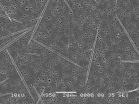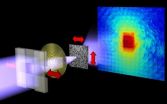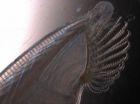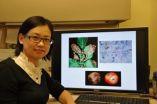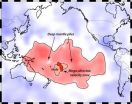(Press-News.org) SAN FRANCISCO, Feb. 6, 2013 -- Nitrogen in ocean waters fuels the growth of two tiny but toxic phytoplankton species that are harmful to marine life and human health, warns a new study published in the Journal of Phycology.
Researchers from San Francisco State University found that nitrogen entering the ocean -- whether through natural processes or pollution -- boosts the growth and toxicity of a group of phytoplankton that can cause the human illness Amnesic Shellfish Poisoning.
Commonly found in marine waters off the North American West Coast, these diatoms (phytoplankton cells) of the Pseudo-nitzschia genus produce a potent toxin called domoic acid. When these phytoplankton grow rapidly into massive blooms, high concentrations of domoic acid put human health at risk if it accumulates in shellfish. It can also cause death and illness among marine mammals and seabirds that eat small fish that feed on plankton.
"Regardless of its source, nitrogen has a powerful impact on the growth of phytoplankton that are the foundation of the marine food web, irrespective of whether they are toxic or not," said William Cochlan, senior research scientist at SF State's Romberg Tiburon Center for Environmental Studies. "Scientists and regulators need to be aware of the implications of both natural and pollutant sources of nitrogen entering the sea."
Nitrogen can occur naturally in marine waters due to coastal upwelling, which draws cool, nutrient-rich water containing nitrate (the most stable form of nitrogen) from deeper depths into sunlit surface waters. Pollution, including agricultural runoff containing fertilizer and effluent from sewage plants, is also responsible for adding nitrogen, including ammonium and urea, to ocean waters, but in most regions these types of nitrogen occur at relatively low concentrations.
In laboratory studies, Cochlan and former graduate student Maureen Auro found that natural and pollution-caused nitrogen forms equally support the growth of the harmful Pseudo-nitzschia algae and cause the production of the domoic acid, but in all cases the natural form of nitrogen caused the most toxic cells.
They also found that these small diatoms became particularly toxic under low light levels – a condition that usually slows the growth of phytoplankton. The species, P. cuspidata, underwent an up to 50 fold increase in toxicity under low light levels compared to the conditions that are thought to normally favor phytoplankton growth.
Scientists already know that in some large-celled species of Pseudo-nitzschia their toxicity increases when the cells grow slower, but in previous studies the slowing of cellular growth was due to the limitation of vital nutrients, such as silicate. However Cochlan's latest study found that the toxicity of these small toxigenic diatoms is affected by the type of nitrogen they consume. He found that under low light levels -- leading to slow growth -- phytoplankton cells that were fed on naturally occurring nitrate were more toxic than cells that were fed on either urea or ammonium caused by pollution.
"Our results demonstrate that the reason for the growth of these specific harmful algal blooms off the coast of North America from British Columbia to California may in fact be due to totally natural causes," Cochlan said.
Such toxic algal blooms may be largely supported by the natural upwelling of nitrogen. However, Cochlan cautions that when the pattern of upwelling is weaker, nitrogen from pollution could play an important role in sustaining a "seed population" of harmful algae – a remnant that keeps the bloom going until upwelling resumes and the bloom is able to grow again and perhaps increase their toxic effect on the marine ecosystem.
"This is the first physiological study to look at the environmental conditions that promote both the growth and the toxicity of these small diatoms," Cochlan said. "The findings may shed light on why these microorganisms produce a potent neurotoxin and what the ecological advantage is for the phytoplankton producing it."
"Nitrogen Utilization and Toxin Production by Two Diatoms of the Pseudo-nitzschia pseudodelicatissima complex: P. cuspidata and P. fryxelliana," was published in the February 2013 issue of the Journal of Phycology. The paper was authored by Maureen E. Auro, a graduate of the marine biology master's program at SF State, and William P. Cochlan, senior research scientist at SF State's Romberg Tiburon Center for Environmental Studies.
INFORMATION:
The study was funded by the National Science Foundation's Ecology and Oceanography of Harmful Algal Blooms program (ECOHAB).
Nitrogen from pollution, natural sources causes growth of toxic algae, study finds
2013-02-07
ELSE PRESS RELEASES FROM THIS DATE:
LSU professor discovers how new corals species form in the ocean
2013-02-07
Since the observations made by English naturalist Charles Darwin on the Galapagos Islands, researchers have been interested in how physical barriers, such as isolation on a particular island, can lead to the formation of new species through the process of natural selection. Natural selection is a process whereby heritable traits that enhance survival become more common in successive generations, while unfavorable heritable traits become less common. Over time, animals and plants that have morphologies or other attributes that enhance their suitability to a particular environment ...
Turning repulsive feelings into desires
2013-02-07
ANN ARBOR—Hunger, thirst, stress and drugs can create a change in the brain that transforms a repulsive feeling into a strong positive "wanting," a new University of Michigan study indicates.
The research used salt appetite to show how powerful natural mechanisms of brain desires can instantly transform a cue that always predicted a repulsive Dead Sea Salt solution into an eagerly wanted beacon or motivational magnet.
Mike Robinson, a research fellow in the U-M Department of Psychology and the study's lead author, said the findings help explain how related brain activations ...
Lower drinking ages lead to more binge drinking
2013-02-07
AUDIO:
In the 1970s and early 1980s, some states lower their minimum legal drinking age below the age of 21. Those lower drinking ages have been linked to bad things, from...
Click here for more information.
People who grew up in states where it was legal to drink alcohol before age 21 are more likely to be binge drinkers later in life, according to a study by researchers at Washington University School of Medicine in St. Louis.
The findings are available online in Alcoholism: ...
Improved X-ray microscopic imaging
2013-02-07
For more than 100 years radiography meant: don't move! In order to visualize nanostructures such as biological cells, the porous structure of cement or storage fields of magnetic disks, the experimentators had to avoid any kind of vibration of X-ray microscope and sample. In addition, only a small percentage fraction of the incoming X-ray radiation could be used. Using special filters, they had to select exactly the fraction with the right properties – for example, the right wavelength.
Contributions of different wavelengths separated
Pierre Thibault of the Technische ...
Breast milk reduces risk of sepsis and intensive care costs in very-low-birth-weight infants
2013-02-07
CHICAGO -- Feeding human breast milk to very-low-birth-weight infants greatly reduces risk for sepsis and significantly lowers associated neonatal intensive care unit (NICU) costs, according to a study by Rush University Medical Center researchers.
The study, published Jan. 31 in the advance online version of the Journal of Perinatology, showed that every 10 milliliters of human milk per kilogram that a very low birth weight infant received during the first 28 days of life decreased the odds of sepsis by almost 20 percent.
A daily dose of 25 to 49.99 milliliters of ...
Sensing the light, but not to see
2013-02-07
WOODS HOLE, MASS. -- Among the animals that are appealing "cover models" for scientific journals, lancelets don't spring readily to mind. Slender, limbless, primitive blobs that look pretty much the same end to end, lancelets "are extremely boring. I wouldn't recommend them for a home aquarium," says Enrico Nasi, adjunct senior scientist at the Marine Biological Laboratory (MBL). Yet Nasi and his collaborators managed to land a lancelet on the cover of the Journal of Neuroscience last December. These simple chordates, they discovered, offer insight into our own biological ...
Scientists identify genetic mechanism that contributed to Irish Famine
2013-02-07
RIVERSIDE, Calif. — When a pathogen attacks a plant, infection usually follows after the plant's immune system is compromised. A team of researchers at the University of California, Riverside focused on Phytophthora, the pathogen that triggered the Irish Famine of the 19th century by infecting potato plants, and deciphered how it succeeded in crippling the plant's immune system.
The genus Phytophthora contains many notorious pathogens of crops. Phytophthora pathogens cause worldwide losses of more than $6 billion each year on potato (Phytophthora infestans) and about ...
The deep roots of catastrophe
2013-02-07
SALT LAKE CITY, Feb. 7, 2013 – A University of Utah seismologist analyzed seismic waves that bombarded Earth's core, and believes he got a look at the earliest roots of Earth's most cataclysmic kind of volcanic eruption. But don't worry. He says it won't happen for perhaps 200 million years.
"What we may be detecting is the start of one of these large eruptive events that – if it ever happens – could cause very massive destruction on Earth," says seismologist Michael Thorne, the study's principal author and an assistant professor of geology and geophysics at the University ...
2 antibodies are better than 1
2013-02-07
Cancer drugs of the new, molecular generation destroy malignant breast tumors in a targeted manner: They block characteristic molecules on tumor cells - receptors for the hormones estrogen or progesterone, or a co-receptor, called HER2, that binds to many growth factors. But about one in every six breast tumors has none of these receptors. Such cancers, called triple-negative, are particularly aggressive and notoriously difficult to treat.
Some of these therapy-resistant cancers have a potential molecular target for cancer drugs, a growth-factor receptor called EGFR, ...
A genetic device performs DNA diagnosis
2013-02-07
Scientists hope that one day in the distant future, miniature, medically-savvy computers will roam our bodies, detecting early-stage diseases and treating them on the spot by releasing a suitable drug, without any outside help. To make this vision a reality, computers must be sufficiently small to fit into body cells. Moreover, they must be able to "talk" to various cellular systems. These challenges can be best addressed by creating computers based on biological molecules such as DNA or proteins. The idea is far from outrageous; after all, biological organisms are capable ...
